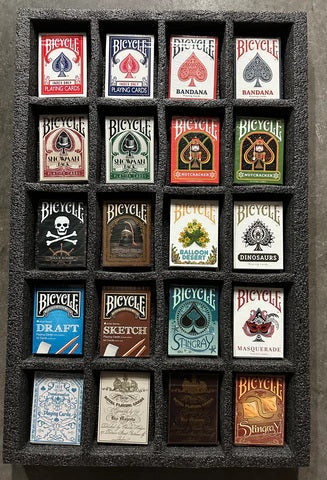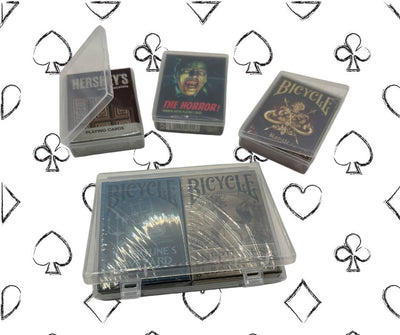Your chance to view the main events from 52 Plus Joker's annual convention
by BoardGameGeek reviewer EndersGameThe 52 Plus Joker Collectors Club
I've never been to a playing card convention. Probably you haven't either. But along with me, today you will. Each October an international playing card convention is organized by 52 Plus Joker, the American Playing Card Collectors Club. But travel restrictions as a result of COVID forced the regular convention to be cancelled in 2020 and again in 2021.So what do you do when it rains lemons? You make lemonade. In light of the unfortunate cancellations, the club made a massive step forward into the 21st century by deciding that they would hold their October 2020 convention virtually using Zoom. Not only did they decide to hold all the lectures and other events online, but they also extended an invitation for playing card collectors around the world to participate, including non-members. It was a brave step, but a bold and successful one, which history will undoubtedly look upon kindly in years to come.
But first, let's share some background about the 52 Plus Joker playing card club. It was formed in 1985, and was originally geared towards the needs of American collectors specializing in antique playing cards. But over time the scope of the club widened to include all kinds of playing cards, and also to encompass collectors world-wide. Today it is the largest playing card club in the world, and represents a vibrant and active community of keen playing card enthusiasts.
The club facilitates collecting and trading, and advances the cause of playing cards generally by means of regular newsletters and magazines like Card Culture and Clear the Decks, organizing auctions, and issuing awards. Under the strong leadership of playing card expert Lee Asher, who has been the Club President since 2016, 52 Plus Joker is easily the premier playing card collecting club, and most of the recognized figures in the playing card community are members.
But the single biggest event in the calendar for 52 Plus Joker is easily their annual convention, which is typically held every October. This represents an opportunity for collectors to come together; buy and trade; meet collectors, designers and manufacturers; chat about playing cards; and perhaps most importantly, have the opportunity to listen to speeches from experts in the field. Sadly, the 2020 convention planned for Pittsburgh, Pennsylvania, wasn't possible, due to the global impact of COVID on travel and meetings. More recently, the 2021 convention planned for Niagara Falls also had to be cancelled, although it is hoped that the presentation of the club's annual Diamond Awards will still be possible in April 2022, as part of a larger event.
An Online Virtual Convention
But as the saying goes, every cloud has a silver lining, and the COVID cloud certainly included a silver lining for playing card enthusiasts. The good news is that the folks over at 52 Plus Joker weren't about to let their cancelled convention plans dampen their enthusiasm completely. It takes more than that to kill the passion of a true collector. So they decided to do something creative and unprecedented: to make the 2020 Convention a virtual one, with all the speeches and meetings by Zoom.We're talking about an online virtual convention, with four full days of events! And best of all for non-members, they opened up everything to the public. For free. In other words, any collector could participate in almost all of the Convention events, even if you weren't a member, and regardless of where in the world you lived.
It was so successful, that when the 2021 convention had to be cancelled as well, they organized a similar event this year, which they called a Virtual Day 2021. The smaller scale the second time around is because it was hoped that it will still be possible to hold some events in person early in 2022. But what a great opportunity to learn, to rub shoulders with some big names, and to get your enthusiasm for playing cards and for collecting fired up! As club president Lee Asher says at one point: "This is the biggest playing card party that the internet has ever seen."
But wasn't the 2020 Convention a year ago now? True, but the good news is that after last year's virtual convention, the tech gurus involved with running it organized edited versions of all the speeches and main events to be available online. Permanently. For free. So now that we're a year further, I figured it would be a great time to post a review of last year's virtual convention, providing a summary of the key things included in each presentation and lecture, and inviting you to check out the full videos of each.
A lot of playing card collectors probably don't even know that this great content is out there. And of those that do, many may not have seen all the lectures and presentations. Thanks to 52 Plus Joker, this is a great opportunity for all of us in the playing card industry to watch some great presentations, and hear some terrific lectures from some carefully selected experts. Best of all, this is almost certain to fire up your enthusiasm, not just for 52 Plus Joker, but for playing cards generally. Let's head to the lecture theater and get started!
== Featured Speakers ==
Kevin Reylek: Marked Cards
Kevin Reylek is the production manager for playing cards over at Penguin Magic, and has been involved in the production of many decks of cards, including the DeLand Centennial Edition decks, and numerous modern custom decks. He has a solid background in magic, and a love for playing cards, particularly marked playing cards, and is extremely well-read and knowledgeable on the subject. In his lecture he focused on the history and styles of factory printed marked cards, as well as some big names in the world of marked decks.How far back do marked decks go? Kevin references various pieces of literature to show that putting marks on cards, starting with simple methods like stains or nicks, seems to have been a practice that dates back as far as playing cards themselves. The first factory produced cards go back to the 1830s, although self-marked decks enjoyed some resurgence in popularity in the late 1800s.
After covering some of the history, Kevin covers key terminology. Perhaps the most important distinction to be familiar with in today's world of marked decks is the difference between coded systems and reader systems. Kevin prefers to call reader systems "openly readable", since he points out that the term "reader" was historically used to refer to any kind of marked deck.
Theodore DeLand (1873-1931) is the single biggest name in the world of marked cards. His work had a huge impact, and many of his methods are still used in modern decks today. Especially influential was his Dollar Deck (also called the Automatic Deck, or the DeLand Deck, or 100 Dollar Deck) which goes back to 1913. It is a stacked stripper deck that uses clock style markings, and remarkably uses 230 marks per card. These not only tell you the identity of the card itself, but also the location and identity of others in the deck. It has inspired modern Bicycle decks like The Code (Andy Nyman) and The Marksman Deck (Luke Jermay). DeLand's edge marking decks also lie behind popular modern decks like Butterfly Playing Cards by Ondrej Psenicka.
Al Baker (1874-1951) seems to have been one of the first to come up with a more openly readable system of markings, which he achieved with scratch work. Today's DMC Elites are a good example of a modern deck that uses Baker's philosophy. In the 1920s a magician by the name of T. Page Wright apparently pioneered using a typewriter to put openly readable marks on the back of cards. Ted Lesley's 1983 book popularized a similar concept for Rider Backs using rub-on transfers. The factory-produced GT Speedreaders deck (Garrett Thomas) is a modern printed deck that employs a similar method but with printed cards.
But the first factory-printed marked Bicycle deck with an openly readable system precedes the GT Speedreaders, and dates from around 2005. It was created by Boris Wild, who cleverly developed the idea of using openly readable marks only for value, and using the placement of these marks on the cards to indicate suit.
Kevin rounds off his lecture by mentioning a few interesting recent marked decks, and some other helpful resources on the subject. It really is a splendid lecture, full of careful references, and many images that show the decks, books, and markings mentioned. It's a must-watch if you like marked cards, or want to learn anything about them. And the Q&A session afterwards is great too, which covers topics like Kevin's personal favourite printed marked decks to use (Penguin Marked Cards and the DMC Elites), the NOC marking system, tactile marking systems, the cleverest versus the worst marking system, and more.
● Video: Marked Cards - lecture (Kevin Reylek)
● Video: Marked Cards - Q&A (Kevin Reylek)
Paul Ruccio: Branding Playing Cards
Paul Ruccio is the founder of Jetsetter Playing Cards, and his talk focuses on branding. Advertising decks have been around for centuries, and we tend to associate branding with decks geared to promote a product. Paul makes the case that almost every creator of a deck of playing cards needs to think about their brand.To illustrate this, he tells the story about how he got to where he is with Jetsetter Playing Cards, and some of the decisions he had to make along the way. One product alone doesn't make a brand. But if you follow up with a second deck, or with other products, then inevitably you are creating a brand. And many elements play a role in shaping what that brand looks like, including the products produced by the brand, the goal of the brand, and the faces and names of the individuals behind the brand.
For Paul, it is important to find other ways to interact with a brand besides the main product. This is something he realized when someone wanted a luggage tag with his brand. Accessories like this can strengthen a brand, and people do want that. In Paul's case, he combined his passion for travel and aviation with his passion for playing cards. That led to his first deck, but more decks would follow, and that's where important decisions were necessary to become a brand.
While Paul's lecture is quite brief, one of the neatest things about it is that he had the video footage shot in an actual hangar, with a real airplane in the background - very appropriate for his own brand! The Q&A afterwards runs on for much longer, and I really learned a lot from the many insights Paul shared. He emphasizes how it is important to think about whether you just intend to produce a single deck, or do more. And if you do more, then you need a larger goal and plan, and this requires careful thought.
There's some great discussion about how businesses can use playing cards for their brand. I'd never thought about Fontaines this way, but Paul points out that Zach Mueller himself is really the pre-existing brand, while his Fontaines deck is really just an extension of that. Zach's decks are often considered "hype decks", but that's really because they are an accessory to the man himself, and people are prepared to spend money on the cards because they are buying into the brand.
Other great aspects of the Q&A include some discussion about what you can learn from failing; how to get feedback from others; thoughts on accessories and apparel; and selecting a playing card printer that fits with your brand.
● Video: Branding Playing Cards - lecture (Paul Ruccio)
● Video: Branding Playing Cards - Q&A (Paul Ruccio)
Michael Slaughter: United States Playing Card Company
Getting Michael Slaughter as a featured speaker was a real coup for the convention, given that he is the current CEO and President of USPCC. The story of how Michael first got his job working for USPCC is a remarkable one, and you'll hear it in the lecture. He originally worked in their casino division, then ran their global sales marketing, and quickly became the president in 2014. It's immediately obvious that Michael is super enthusiastic about playing cards and about the USPCC brand, and that he's committed to building a lasting legacy, and to preserving the rich heritage that he sees himself as a steward of.Michael begins by highlighting some facts about the state of the playing card industry, which is thriving. COVID has led many people back to enjoying playing cards, and USPCC is working hard to keep this fresh, and to prevent things becoming tired and old. If USPCC is any reliable indication, the playing card industry is not in decline, because sales have been through the roof in recent times.
The historical section of the lecture is especially interesting, because Michael's own past is closely wrapped up with USPCC. He grew up as a child in Norwood, which is where USPCC's Norwood facility was located. As a youngster, he would often ride his bike to the factory, so he has a long personal connection with it. He mentions that its iconic clock tower was even used by locals like him as a geographic reference point. Michael even remembers going to the factory for a third grade field trip, and playing baseball at a nearby park.
The Norwood facility was built in 1899, but is now being deconstructed, given that the company has been operating in a new facility in Erlanger since July 2009. But they have been able to save some artifacts from the old facility. Michael shows us parts of the old empty building, which has some fascinating aspects about it. The old property is going to be used for housing and retail outlets, and these are set to include a museum for USPCC, and maybe even their own retail store.
Michael also shares some photos from inside the newer Erlanger facility, and we learn that the production of playing cards is much more complex than just printing on paper. What especially makes USPCC unique is that they are the only playing card company in the world that manufactures their own card stock, which has the real advantage that they can control all aspects of the quality of their playing cards.
But Michael's presentation isn't only about the past, because he also gives us a few sneak peeks about the future. He makes some important comments about the recent acquisition of USPCC by Cartamundi. He doesn't see this as a negative, because Cartamundi has a long history, and like USPCC is very proud of their playing card heritage. USPCC realizes that card players also play other games, so lately they have been expanding their range by launching a number of social games and party games. They are even looking at expanding further towards becoming a lifestyle brand, by offering products like Bicycle-branded apparel.
In the Q&A segment that follows his lecture, Michael adds some more great thoughts about the future of playing cards. While they go back centuries, in his view they will always be part of our culture. We live in a golden age of playing cards, but he really sees the need to keep things fresh, and to introduce playing cards to a new generation. Other interesting areas covered in the Q&A section include Michael's thoughts about republishing historic card backs; why he loves the classic Bicycle Rider Back; why USPCC doesn't give facility tours; USPCC's appreciation for collectors and history; and some things USPCC does to ensure quality and consistency.
● Video: United States Playing Card Company - lecture and Q&A (Michael Slaughter)
Where to learn more? Official website for the 52 Plus Joker American Playing Card Collectors Club
About the writer: EndersGame is a well-known and respected reviewer of board games and playing cards. He loves card games, card magic, cardistry, and card collecting, and has reviewed several hundred boardgames and hundreds of different decks of playing cards. You can see a complete list of his game reviews here, and his playing card reviews here. He is considered an authority on playing cards and has written extensively about their design, history, and function, and has many contacts within the playing card and board game industries. You can view his previous articles about playing cards here. In his spare time he also volunteers with local youth to teach them the art of cardistry and card magic.





